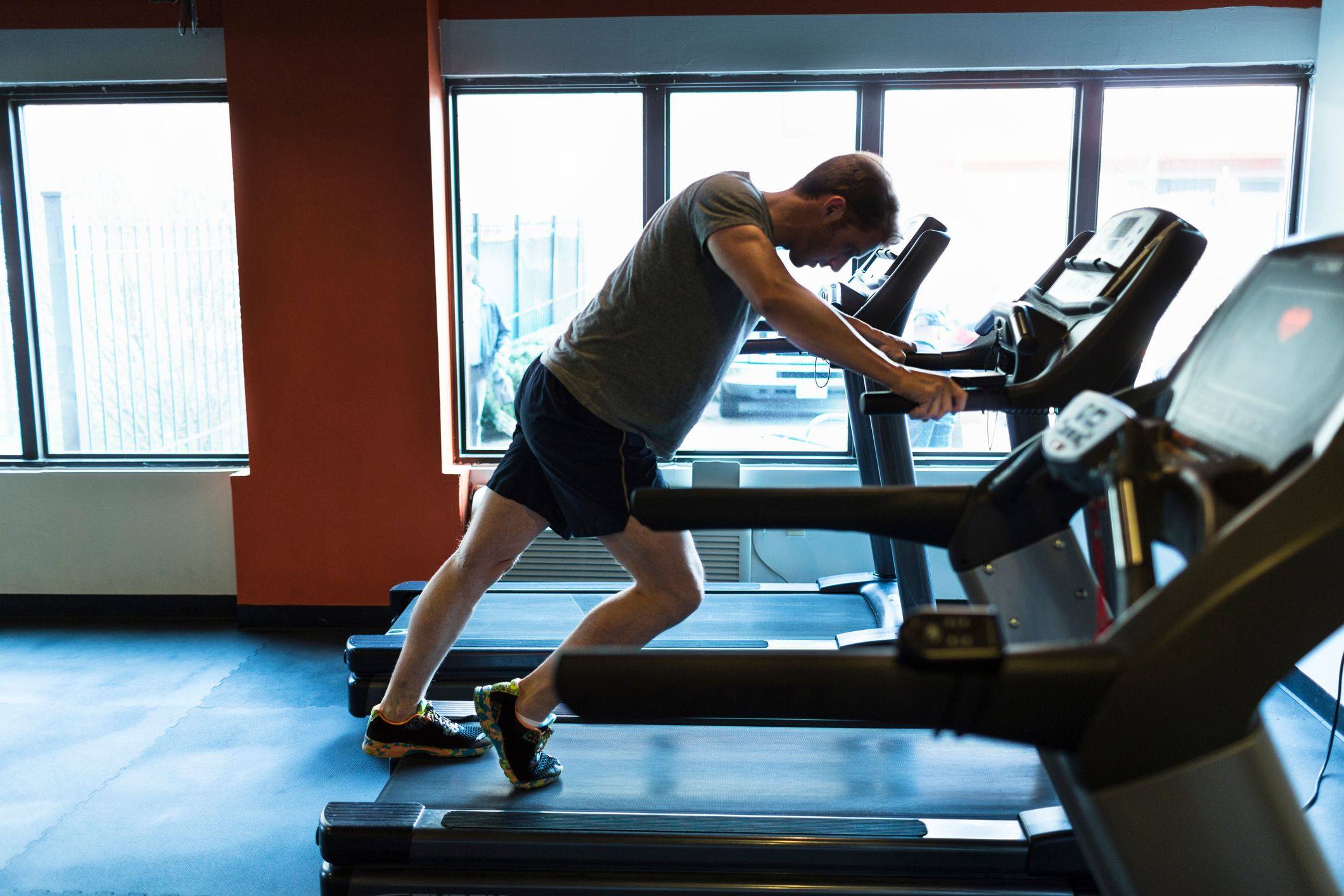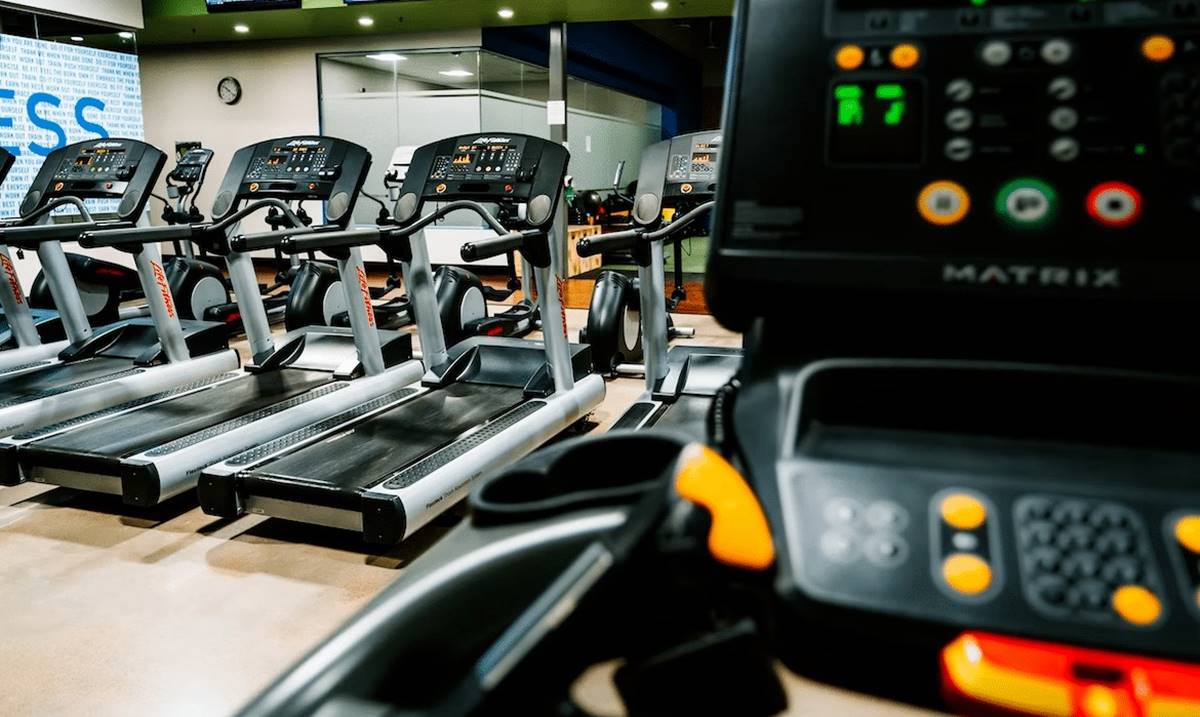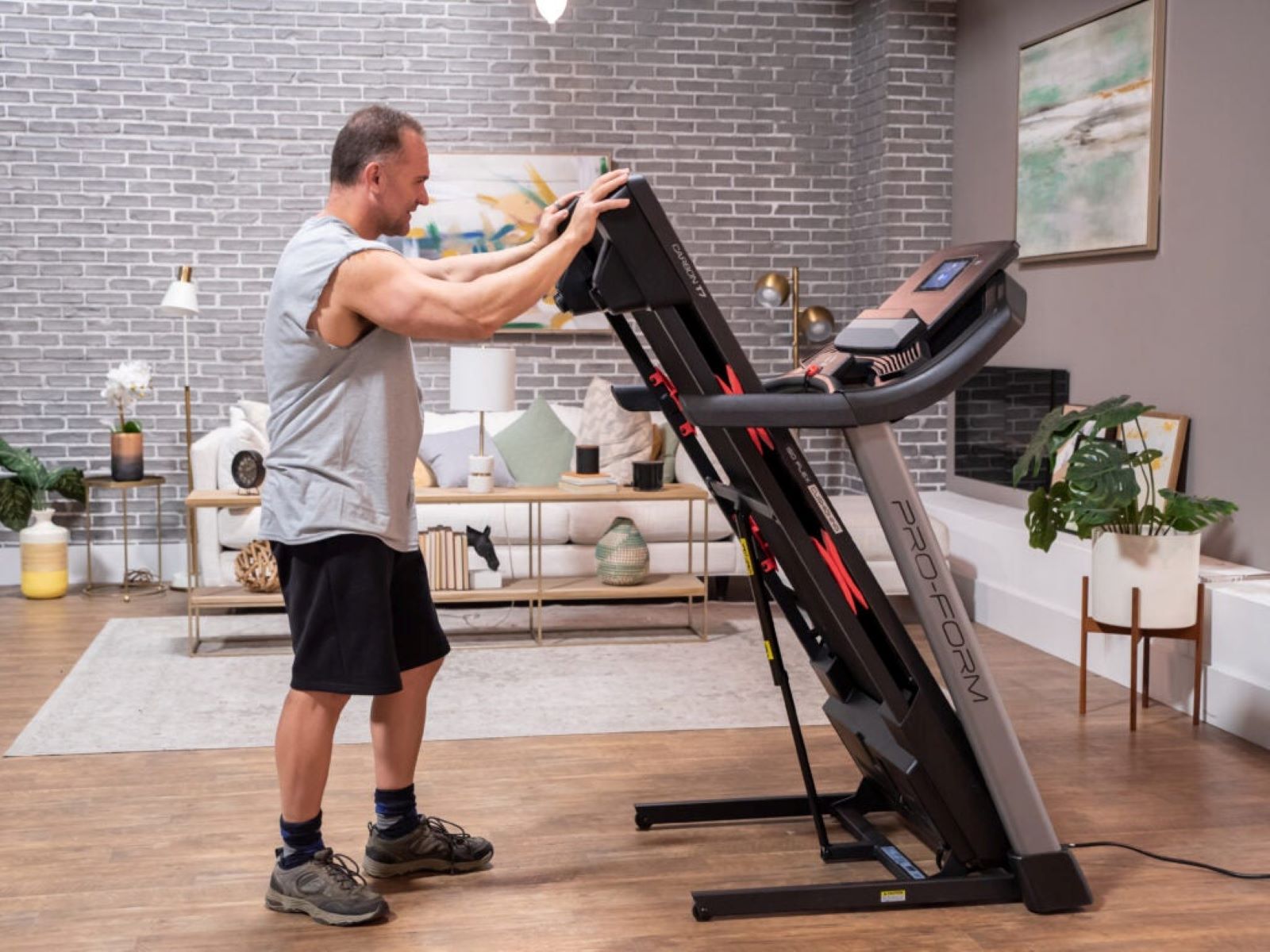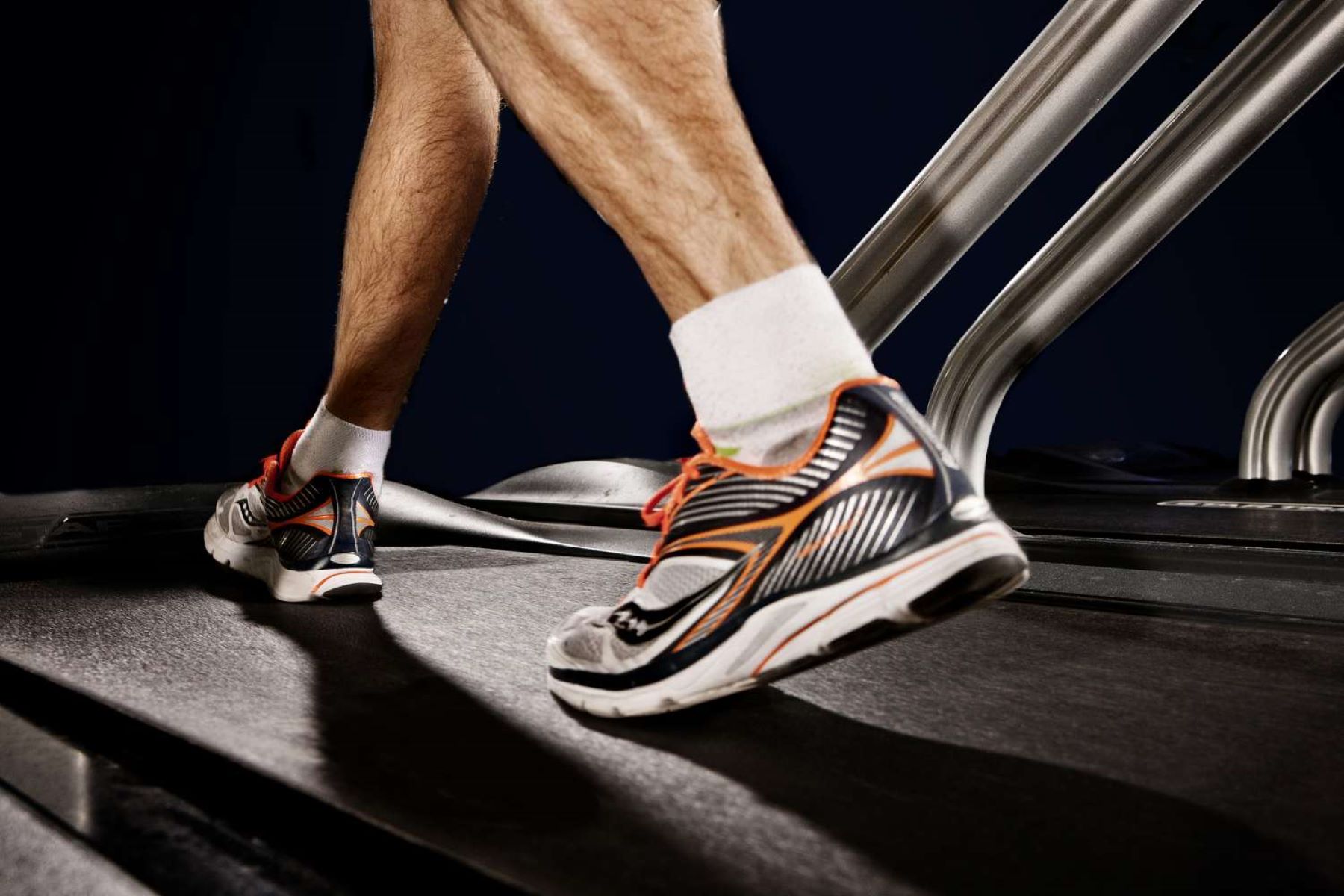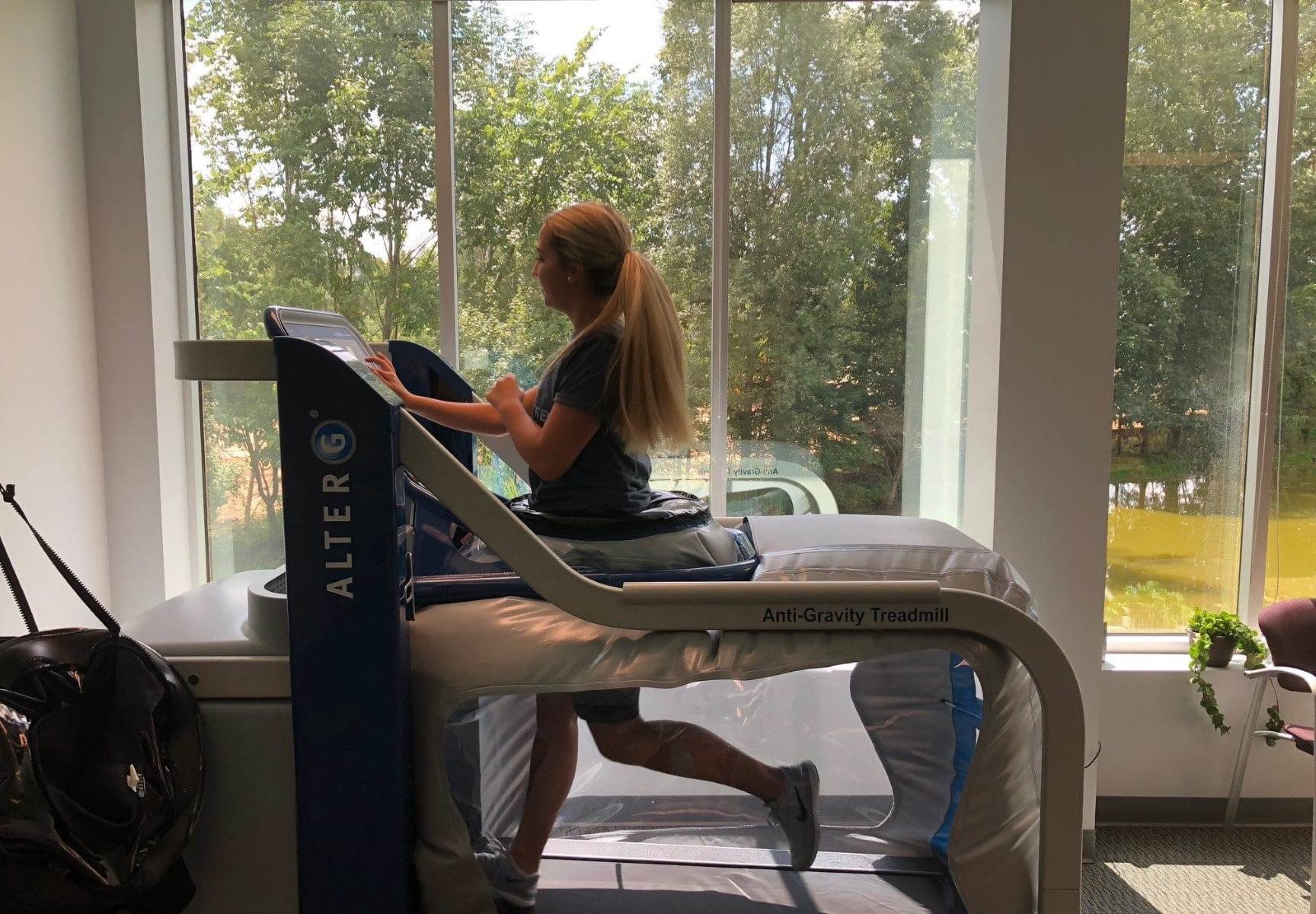Home>Misc>Featured>What Does Running On A Treadmill Do For You
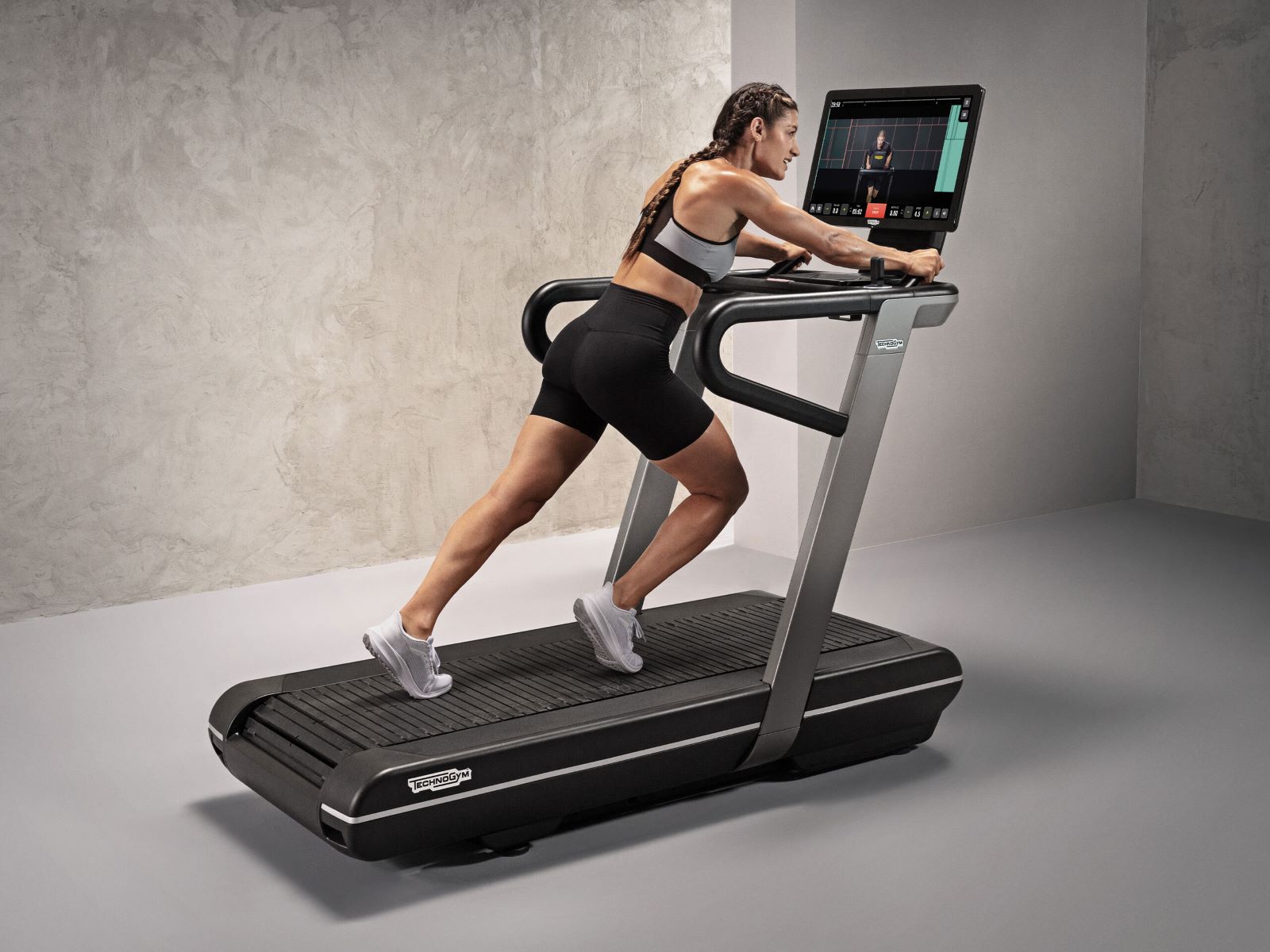

Featured
What Does Running On A Treadmill Do For You
Published: August 29, 2023
Discover the amazing benefits of running on a treadmill with our featured article. Improve fitness, burn calories, and achieve your goals with this versatile exercise machine!
Introduction
Running is a popular form of exercise that offers numerous health benefits and helps individuals stay fit and active. While many enjoy running outdoors, others prefer the convenience and accessibility of running on a treadmill. A treadmill is a stationary exercise machine with a moving platform that allows users to simulate running or walking indoors. This article will delve into the benefits of running on a treadmill, including improved cardiovascular health, weight loss and calorie burning, joint impact reduction, and the convenience of an indoor workout.
Treadmill running provides a controlled and predictable environment for individuals to work on their fitness goals. Whether the weather is unfavorable or safety concerns arise, running on a treadmill offers a suitable alternative that allows individuals to maintain their running routine without any interruptions. Additionally, treadmills provide options for adjusting speed, incline, and other settings, allowing users to customize their workouts according to their fitness level and goals.
It’s important to understand that running on a treadmill is not a replacement for outdoor running, but rather an alternative that offers its own unique advantages and disadvantages. By exploring the benefits and drawbacks of treadmill running, individuals can make informed decisions and choose the exercise method that best suits their needs and preferences.
Benefits of Running on a Treadmill
Running on a treadmill offers a range of benefits that can contribute to overall fitness and well-being. Whether you’re a beginner or an experienced runner, incorporating treadmill workouts into your routine can help you achieve your fitness goals. Let’s take a closer look at some of the key advantages of running on a treadmill:
- Improved Cardiovascular Health: Regular cardiovascular exercise is essential for maintaining a healthy heart and lungs. Running on a treadmill elevates your heart rate, increasing blood flow throughout your body and strengthening your cardiovascular system. This can lead to improved endurance and a reduced risk of heart disease.
- Weight Loss and Calorie Burning: Running is an excellent way to burn calories and lose weight. Treadmill workouts can help you achieve your weight loss goals by increasing your metabolism and burning excess calories. Moreover, most treadmills provide features that allow you to track your progress, such as distance covered, calories burned, and heart rate, providing valuable feedback for your fitness journey.
- Joint Impact Reduction: Compared to running on hard outdoor surfaces, treadmills offer a cushioned and shock-absorbing platform. This helps reduce the impact on your joints, making it a suitable option for individuals with joint pain or those recovering from injuries. Treadmills with adjustable cushioning further enhance joint protection and provide a comfortable running experience.
- Convenient Indoor Workout: One of the greatest advantages of running on a treadmill is the convenience it offers. With a treadmill, you can exercise anytime, regardless of weather conditions or safety concerns. Whether it’s early morning or late at night, having a treadmill at home or in a gym allows you to squeeze in a workout without worrying about external factors that may limit your outdoor running routine.
- Varied Workout Options: Treadmills come equipped with various features that allow you to customize your workouts. You can adjust the speed, incline, and even choose pre-programmed workout routines that simulate different terrains or interval training. These options make treadmill running versatile and enable you to challenge yourself, prevent boredom, and target specific fitness goals.
By tapping into these benefits, individuals can enhance their fitness journey and enjoy the convenience, effectiveness, and versatility of treadmill running. However, it is essential to consider the potential drawbacks of running on a treadmill to make an informed decision and maintain a balanced fitness routine.
Improved Cardiovascular Health
Running on a treadmill is an excellent way to improve cardiovascular health. Regular cardiovascular exercise helps strengthen the heart and lungs, enhances circulation, and improves overall fitness. Here are the key ways in which running on a treadmill benefits your cardiovascular system:
Elevated Heart Rate: Running on a treadmill increases your heart rate, pushing it into the target heart rate zone. This sustained elevation in heart rate during your workout strengthens the heart muscle, improving its efficiency and ensuring optimal blood circulation throughout the body. A stronger heart can pump blood more effectively, delivering oxygen and nutrients to the muscles and organs.
Improved Endurance: Treadmill running aids in enhancing endurance, allowing you to exercise for longer periods without becoming easily fatigued. As you consistently engage in treadmill workouts, your body adapts to the increased demands placed on it, leading to improved stamina and endurance. This can be particularly beneficial for athletes or individuals participating in endurance-based activities such as long-distance running or cycling.
Lowered Risk of Heart Disease: Engaging in regular treadmill running can help reduce the risk of heart disease. Cardiovascular exercise, such as running, strengthens the heart and blood vessels, lowers blood pressure, and improves cholesterol levels. These factors collectively contribute to a healthier cardiovascular system and a reduced risk of developing heart-related conditions.
Weight Management: Running on a treadmill can be an effective tool for weight management, which is closely linked to cardiovascular health. Regular treadmill workouts can help burn calories, promote fat loss, and maintain a healthy body weight. Excess weight puts strain on the cardiovascular system and increases the risk of heart disease, making weight management an important aspect of cardiovascular health.
Stress Reduction: Running on a treadmill offers not only physical but also mental benefits. Regular exercise has been shown to reduce stress levels and improve overall mood. When you run on a treadmill, your brain releases endorphins, also known as “feel-good” hormones, which can boost your mood and reduce stress. The combination of physical exertion and stress relief contributes to better cardiovascular health and overall well-being.
By incorporating treadmill running into your fitness routine, you can significantly improve your cardiovascular health. It not only strengthens your heart but also enhances endurance, reduces the risk of heart disease, aids in weight management, and promotes mental well-being. However, it is essential to consult with a healthcare professional before starting a new exercise regimen, especially if you have any pre-existing medical conditions.
Weight Loss and Calorie Burning
Running on a treadmill is an effective way to burn calories and support weight loss efforts. Whether you’re looking to shed a few pounds or maintain a healthy weight, treadmill running can be a valuable tool in your fitness journey. Here are the key ways in which running on a treadmill helps with weight loss and calorie burning:
Increased Caloric Expenditure: Running, in general, is a high-intensity cardiovascular exercise that expends a significant number of calories. When you run on a treadmill, your body is engaged in continuous movement, which burns calories at a higher rate compared to other forms of exercise. The faster and more intense your workout, the more calories you will burn during your treadmill session.
Effective Fat Burning: Treadmill running can be particularly effective for burning fat, as it engages various muscle groups and helps elevate your heart rate. When you perform aerobic exercise like running on a treadmill, your body primarily relies on fatty acids as a fuel source. As a result, consistent treadmill workouts can help reduce excess body fat and improve body composition.
Customizable Intensity: One of the advantages of running on a treadmill is the ability to control and adjust the intensity of your workout. Most treadmills offer features such as speed and incline adjustments, allowing you to challenge yourself and keep your body constantly challenged. By increasing the intensity of your treadmill runs, you can burn more calories and elevate your metabolism, even after your workout.
Tracking and Accountability: Treadmills typically come equipped with various tracking features that allow you to monitor your progress, including distance, speed, calories burned, and heart rate. This valuable feedback can help you stay accountable and motivated as you work towards your weight loss goals. By seeing tangible results and tracking your calorie burn, you can make necessary adjustments to your routine and continue making progress.
Combination with Intervals: Treadmill running is well-suited for incorporating interval training, which involves alternating between high-intensity bursts and recovery periods. This method has been shown to increase calorie burn and fat loss, as well as improve cardiovascular fitness. By alternating between running at a challenging pace and a slower recovery pace, you can maximize your calorie burn and amplify the weight loss benefits.
While treadmill running can be an effective tool for weight loss, it’s important to note that achieving and maintaining a healthy weight is a multifaceted process that also encompasses proper nutrition and overall lifestyle choices. Nonetheless, incorporating regular treadmill workouts into your routine can significantly contribute to your weight loss efforts and overall fitness goals.
Joint Impact Reduction
One of the significant advantages of running on a treadmill is the reduced impact on your joints compared to running on hard outdoor surfaces. Treadmills offer a cushioned and shock-absorbing platform that helps minimize the stress and impact on your joints, making it an ideal choice for individuals with joint pain or those recovering from injuries. Here are the key ways in which running on a treadmill reduces joint impact:
Cushioned Surface: Most treadmills are designed with a cushioned surface that absorbs shock and provides a softer landing for your feet. This feature helps distribute the impact of each stride evenly, reducing the strain on your knees, hips, and ankles. The cushioning can be adjusted on some treadmills, allowing you to customize the level of impact absorption to suit your preferences and comfort.
Even Surface: Treadmills offer a consistent and predictable surface, eliminating the uneven terrain often found outdoors. Uneven surfaces, such as trails or sidewalks, pose a higher risk of tripping or twisting your ankle, which can lead to joint injuries. By running on a treadmill, you can maintain a steady stride and minimize the risk of putting stress on your joints due to unexpected surface variations.
Reduced Joint Strain: The cushioning and consistent surface of treadmills help distribute the force of impact more evenly throughout your body, relieving excessive strain on your joints. This can be particularly beneficial for individuals with conditions such as osteoarthritis, where high-impact activities can exacerbate pain and discomfort. By running on a treadmill, you can engage in a low-impact form of exercise that minimizes joint strain while still reaping the cardiovascular benefits.
Lower Risk of Overuse Injuries: Overuse injuries, such as shin splints and stress fractures, are common among runners. These injuries often occur due to repetitive impact and strain on specific joints or bones. Running on a treadmill with a cushioned surface can help reduce the risk of these injuries by providing a gentler impact on your joints. Additionally, the adjustable settings on treadmills allow you to gradually increase intensity and distance, preventing sudden spikes in training volume and minimizing the risk of overuse injuries.
Rehabilitation and Recovery: Treadmill running can be beneficial for individuals recovering from joint injuries or undergoing rehabilitation. The controlled environment and reduced impact make it a safer option for gradually reintroducing movement and building strength. Treadmills also offer the advantage of adjustable speed and incline, allowing you to control the intensity of your workouts based on your specific needs and abilities during the recovery process.
While running on a treadmill significantly reduces joint impact, it is important to maintain good running form and avoid excessive strain on your joints. It’s always advisable to start with shorter sessions and gradually increase your running time and intensity to allow your body to adapt. Additionally, wearing proper footwear and using appropriate running techniques can further enhance the joint-friendly benefits of treadmill running.
Convenient Indoor Workout
One of the main advantages of running on a treadmill is the convenience it offers as an indoor workout option. Whether it’s unfavorable weather conditions or safety concerns, a treadmill provides a suitable alternative that allows individuals to maintain their running routine without any interruptions. Here are the key reasons why a treadmill offers a convenient indoor workout:
Weather Independence: With a treadmill, you no longer have to worry about the unpredictability of weather conditions. Whether it’s raining, snowing, or too hot outside, you can still engage in your running workouts comfortably indoors. This eliminates the need to reschedule or skip a workout due to inclement weather and ensures that you can stay consistent with your training regimen.
24/7 Accessibility: Treadmills are available for use at any time of the day, providing flexibility for individuals with packed schedules or varying work hours. Whether you’re an early riser who prefers morning workouts or someone who prefers evening exercise, having access to a treadmill allows you to fit in your workout whenever it’s most convenient for you.
Safety and Security: Running outside, especially in unfamiliar or dimly lit areas, can sometimes raise safety concerns. By running on a treadmill indoors, you eliminate potential risks associated with running in isolated or unsafe environments. Additionally, the controlled environment of a treadmill ensures that you are running on a stable surface, reducing the risk of tripping or falling.
Minimal Equipment Set-Up: Treadmills provide a hassle-free workout experience without the need for extensive equipment set-up. Simply hop on the treadmill, adjust the settings to your desired speed and incline, and you’re ready to go. This saves you time and effort compared to other indoor exercise options that may require assembling equipment or setting up a designated workout area.
Multitasking Possibilities: Running on a treadmill indoors offers the opportunity to multitask and make the most of your time. You can catch up on your favorite TV shows, listen to audiobooks or podcasts, or even respond to emails while getting your workout in. This makes treadmill running a productive use of your time and allows you to combine exercise with other activities.
Running on a treadmill provides the convenience and flexibility to maintain a consistent workout routine regardless of external factors. However, it’s important to note that outdoor running offers its own unique benefits, such as exposure to fresh air and varying terrain. By being mindful of your goals, preferences, and circumstances, you can choose to incorporate both treadmill running and outdoor running to create a well-rounded exercise routine that aligns with your needs.
Varied Workout Options
Running on a treadmill offers a range of workout options that can keep your exercise routine exciting, challenging, and effective. Treadmills come with various features and settings that allow you to customize your workouts and target different fitness goals. Here are the key ways in which treadmill running provides varied workout options:
Speed Control: One of the significant advantages of running on a treadmill is the ability to control and adjust the speed of your run. You can set the pace to match your preferred running speed or challenge yourself by gradually increasing the speed over time. This flexibility allows you to adapt your workouts based on your fitness level, enabling continuous progression and improvement.
Incline Training: Treadmills often come equipped with incline settings, replicating the uphill and downhill challenges of outdoor running. By adjusting the incline, you can simulate running on hilly terrains, engaging different muscle groups and intensifying your workout. Incline training helps increase calorie burn, build lower body strength, and improve cardiovascular fitness.
Pre-Programmed Workouts: Many treadmills offer pre-programmed workouts that can simulate different terrains, interval training, or specific training programs. These workouts come with predetermined speed and incline variations, guiding you through a structured training session. By selecting the appropriate program, you can add variety to your workouts and target specific fitness goals, such as endurance, speed, or fat burning.
Virtual Courses and Entertainment: Some advanced treadmills provide interactive features that allow you to virtually run courses or races from around the world. These immersive experiences provide visual and audio cues as you run, making your indoor workouts more engaging and enjoyable. Additionally, many treadmills offer built-in entertainment options like streaming services or compatibility with mobile devices, allowing you to watch movies, TV shows, or listen to music during your runs.
Interval Training: Treadmill running lends itself well to interval training, a highly effective method of alternating between high-intensity bursts and recovery periods. You can manually adjust the speed and incline settings on the treadmill, creating intervals that challenge your cardiovascular system and boost calorie burn. Interval training is an excellent way to improve endurance, burn fat, and increase overall fitness levels.
By leveraging these varied workout options, you can keep your treadmill runs interesting, prevent monotony, and continually challenge your body. Experiment with different settings, try new pre-programmed workouts, and incorporate interval training to maximize the benefits of treadmill running. However, remember to listen to your body, progress gradually, and seek guidance from a fitness professional if needed to ensure proper form and technique.
Potential Drawbacks of Running on a Treadmill
While running on a treadmill offers numerous benefits, it is essential to consider the potential drawbacks to make an informed decision about your exercise routine. Here are some of the potential drawbacks of running on a treadmill:
Lack of Real-World Terrain and Elements: Treadmills provide a controlled and consistent surface, but they lack the irregular terrain and outdoor elements you encounter during outdoor running. Running on a treadmill may not fully replicate the challenges of running on natural surfaces like trails or uneven pavement. This difference can affect the engagement of certain muscles and the proprioception required to navigate varying terrain.
Less Engagement of Stabilizing Muscles: When running outdoors, your body must navigate uneven surfaces and adjust to changes in terrain, engaging a wider range of stabilizing muscles. On a treadmill, the surface is flat and predictable, reducing the demand on these muscles. This difference may lead to a less comprehensive workout and potentially miss out on strengthening certain muscle groups.
Potential Boredom Factor: Running on a treadmill can become monotonous, especially during longer duration workouts. The lack of scenery and outdoor distractions can make the time pass more slowly, leading to potential boredom. It is important to find ways to stay motivated and engaged during treadmill runs, such as watching TV shows or movies, listening to music or podcasts, or varying your workout routines.
Limitations on Outdoor Training-Specific Skills: Running on a treadmill may not provide the opportunity to develop certain outdoor-specific skills, such as running in different weather conditions, adjusting to wind resistance, or navigating obstacles. If you are training for outdoor events or races, it is important to supplement treadmill running with outdoor training to adequately prepare for specific challenges.
Monotony in Stride and Movement: Treadmills dictate a specific stride pattern, limiting natural variations in stride length and foot placement that occur during outdoor running. This consistent movement pattern may lead to muscle imbalances or repetitive stress injuries if proper form and technique are not maintained. Varying your speed, incline, and incorporating cross-training activities can help counteract these potential issues.
While these drawbacks should be considered, it is important to remember that treadmill running can still be an effective and enjoyable exercise option. By being mindful of the potential limitations and taking steps to address them, such as incorporating outdoor runs or cross-training activities, you can create a well-rounded and balanced exercise routine that meets your fitness goals.
Lack of Real-World Terrain and Elements
One of the potential drawbacks of running on a treadmill is the lack of real-world terrain and elements. While treadmills provide a controlled and consistent surface for running, they cannot fully replicate the challenges and variations you experience when running outdoors. Here are some key considerations related to the absence of real-world terrain and elements when running on a treadmill:
Muscle Engagement: When running outdoors, you encounter different terrains such as grass, trails, and pavements, which require your body to adapt and engage a wider range of muscles. The irregular surfaces and various slopes of outdoor terrain activate stabilizing muscles that are essential for balance and posture. On a treadmill, the consistent and flat surface may not engage these muscles to the same extent, potentially leading to muscle imbalances or weaknesses.
Proprioception and Balance: Outdoor running requires constant adjustments to changes in terrain, elevation, and obstacles, which challenge your proprioceptive abilities. Proprioception refers to your body’s awareness and sense of position in space. Running on a treadmill eliminates the need for these constant adjustments, potentially reducing the development of proprioceptive skills necessary for dynamic movement and balance.
Mental Stimulation: Running outdoors offers a dynamic and visually stimulating experience, with changing surroundings and exposure to nature. The treadmill, on the other hand, may lack the same level of mental stimulation as it provides a stationary and repetitive environment. The absence of outdoor elements such as fresh air, varying weather conditions, and changing scenery can contribute to potential boredom during treadmill runs.
Training Specificity: If you have specific outdoor running goals, such as preparing for a race or event, it is important to incorporate outdoor training to simulate the challenges you’ll face. Treadmill running alone may not fully prepare you for the real-world conditions you’ll encounter during your race, such as wind resistance, uneven terrain, or navigating obstacles. It is crucial to adapt your training to include outdoor runs to improve your performance and adaptability.
Variability of Surface: Outdoor running exposes your body to different surfaces, such as concrete, grass, or sand. Each surface demands slightly different movements and engages different muscle groups. While the cushioning on a treadmill helps reduce impact, it does not fully replicate the variations in surface and impact forces that occur outdoors.
While running on a treadmill offers convenience and controllability, it is important to supplement treadmill running with outdoor runs or cross-training activities to counteract the potential drawbacks of the lack of real-world terrain and elements. Incorporating outdoor runs not only adds variety and engagement but also allows your body to adapt to different surfaces and challenges. Remember to listen to your body, maintain proper form and technique, and gradually incorporate outdoor running into your training routine to optimize your overall running experience.
Less Engagement of Stabilizing Muscles
One potential drawback of running on a treadmill is the reduced engagement of stabilizing muscles compared to running outdoors. When running on a treadmill, the flat and consistent surface eliminates the need to constantly adapt to uneven terrain and obstacles, resulting in less activation of certain muscle groups. Here are some key considerations related to the potential less engagement of stabilizing muscles during treadmill running:
Muscle Imbalances: Running outdoors requires your body to adjust to irregular surfaces, which engages a wide range of stabilizing muscles. These muscles, including the core, glutes, and hip stabilizers, play a crucial role in providing stability, balance, and proper form while running. However, treadmill running may not engage these muscles to the same extent, potentially contributing to muscle imbalances and weaknesses.
Incomplete Physical Development: By running on a treadmill, you may miss out on the opportunity to fully develop and strengthen certain stabilizing muscles. Outdoor running engages these muscles as they constantly adapt to the varying terrain, helping to improve overall body stability and coordination. Neglecting the engagement of stabilizing muscles can limit your performance potential and increase the risk of injury.
Core Strength and Stability: Treadmill running may not fully engage the core muscles as effectively as running outdoors. Running on uneven terrain outdoors requires greater core engagement to maintain balance and stability. Strengthening the core is important for maintaining proper posture, reducing the risk of lower back pain, and improving overall running efficiency. It is crucial to incorporate core-strengthening exercises, such as planks or exercises with stability balls, to compensate for the reduced core engagement during treadmill running.
Balance and Coordination: Running outdoors challenges your body’s balance and coordination as you navigate varying surfaces, slopes, and obstacles. These skills are crucial for dynamic movement and injury prevention. Running on a treadmill may not offer the same level of balance and coordination training that occurs naturally during outdoor running.
Addressing the Issue: To counteract the potential less engagement of stabilizing muscles during treadmill running, it is important to incorporate exercises that specifically target these muscles. Strength training exercises, such as lunges, squats, and lateral movements, can help improve stability and strengthen the muscles not as engaged during treadmill running. Additionally, integrating other forms of exercise, such as balance training, yoga, or Pilates, can further enhance overall muscle engagement and development.
While treadmill running provides convenience and control, it’s important to incorporate exercises that target stabilizing muscles to avoid muscle imbalances and weaknesses. By dedicating time to strengthen these muscles through targeted exercises, you can enhance your overall stability, improve running mechanics, and reduce the risk of injuries. Maintaining a well-rounded fitness routine that includes strength and balance training, along with treadmill running, will help maximize your running potential.
Potential Boredom Factor
One potential drawback of running on a treadmill is the potential for boredom during your workouts. Unlike running outdoors, which offers changing scenery and varied surroundings, treadmill running takes place in a controlled and stationary environment. Here are some key considerations related to the potential boredom factor of treadmill running:
Lack of Changing Scenery: Running outdoors exposes you to different landscapes, natural elements, and changing scenery, which can help keep your runs visually stimulating and interesting. On a treadmill, the scenery remains the same, potentially leading to monotony and boredom during longer workout sessions.
Mental Stimulation: The repetitive motion and lack of outdoor distractions on a treadmill can make your runs mentally monotonous. Without the variation in terrain and the ever-changing outdoor elements, treadmill running may feel less mentally engaging. This lack of mental stimulation can contribute to a sense of boredom and reduce workout enjoyment.
Challenge of Long Duration Runs: Longer duration runs on a treadmill can be mentally challenging due to the stationary nature of the workout. Without the distraction and engagement of outdoor surroundings, the time spent running can feel prolonged, leading to potential boredom. Finding ways to stay mentally engaged and motivated during extended treadmill runs is important to maintain consistency in your training.
Addressing the Boredom Factor: While treadmill running can be perceived as monotonous, there are strategies to help combat the potential boredom and keep your workouts enjoyable:
- Music and Entertainment: Listening to music, audiobooks, podcasts, or watching TV shows or movies can provide entertainment and distraction during your treadmill runs.
- Virtual Courses or Races: Some treadmills offer features that allow you to virtually run courses or races from around the world. These interactive features provide visual and audio cues, enhancing your running experience on a treadmill.
- Variation in Workout Routine: Incorporating interval training, speed workouts, or hill workouts on your treadmill can add variation to your routine, making your runs more engaging and challenging.
- Mental Engagement Techniques: Using visualization techniques, setting goals, or focusing on different aspects of your running form can help keep your mind engaged and alleviate boredom during treadmill runs.
- Outdoor Runs: Combining your treadmill runs with outdoor runs can diversify your training routine and provide the mental and visual stimulation that comes with running in different environments.
By applying these strategies and finding what works best for you, you can minimize the potential boredom factor and make your treadmill runs more enjoyable and engaging. Experimenting with different techniques and incorporating variety into your workouts will help you stay motivated and committed to your running routine.
Safety Considerations While Using a Treadmill
While running on a treadmill can provide a safe and controlled exercise environment, it is important to prioritize safety to prevent accidents or injuries. Here are some key safety considerations to keep in mind while using a treadmill:
Proper Footwear: Wearing appropriate footwear is essential for a safe and comfortable treadmill workout. Make sure to wear running shoes that provide adequate cushioning, support, and a good grip to prevent slipping or foot fatigue during your runs.
Warm-up and Cool-down: Before and after each treadmill session, it is important to perform a proper warm-up and cool-down routine. Warm-up exercises, such as light jogging or dynamic stretches, help prepare your muscles for the workout, while cool-down exercises, such as walking or static stretches, help promote recovery and reduce muscle soreness.
Gradual Progression: When using a treadmill, it’s crucial to start slowly and gradually increase the intensity and duration of your runs. Sudden increases in speed or incline can put excessive strain on your muscles and joints, increasing the risk of injury. Listen to your body and allow for sufficient recovery between workouts to avoid overexertion.
Proper Form: Maintaining proper running form is important to minimize the risk of injury while using a treadmill. Keep your posture upright, relax your shoulders, engage your core muscles, and maintain a natural arm swing throughout your workout. Avoid leaning too far forward or backward and maintain a comfortable stride length.
Safety Clip and Emergency Stop Button: Most treadmills come equipped with a safety clip that attaches to your clothing. This clip is designed to automatically stop the treadmill if you accidentally fall or lose your balance. Make sure to use the safety clip and familiarize yourself with the location of the emergency stop button in case you need to quickly stop the machine.
Adequate Hydration: Staying properly hydrated is crucial for any workout, including treadmill running. Remember to drink water before, during, and after your treadmill sessions to prevent dehydration. Keep a water bottle nearby for easy access during your workout.
Clear Surroundings: Ensure that the area around the treadmill is clear of any potential hazards or objects that could interfere with your workout. Make sure there is sufficient space behind and on the sides of the treadmill to prevent accidents or tripping.
Monitoring Heart Rate: Monitoring your heart rate during treadmill workouts is important for understanding your exertion level. Many treadmills have built-in heart rate monitors, or you can use a wearable device to track your heart rate. Pay attention to any unusual or prolonged changes in heart rate and adjust your workout intensity accordingly.
Listening to Your Body: Ultimately, the most important safety consideration is listening to your body. If you experience any pain, dizziness, or unusual discomfort during your treadmill workout, stop immediately and seek medical attention if needed. Pushing through pain or discomfort can lead to further injury.
By prioritizing safety and following these considerations, you can enjoy a safe and effective treadmill workout. Remember to always use common sense, be aware of your surroundings, and consult with a healthcare professional before starting any new exercise routine or if you have any pre-existing medical conditions.
Conclusion
Running on a treadmill offers a variety of benefits, making it a viable option for individuals seeking a convenient and effective indoor workout. Treadmill running provides improved cardiovascular health, aids in weight loss and calorie burning, reduces joint impact, and offers the flexibility of a convenient indoor workout. However, it is important to be aware of potential drawbacks, including the lack of real-world terrain and elements, less engagement of stabilizing muscles, potential boredom factor, and safety considerations.
Despite these drawbacks, the convenience, controllability, and versatility of treadmill running make it a valuable addition to a well-rounded fitness routine. By understanding the potential limitations and implementing strategies to address them, such as incorporating outdoor runs, varying workouts, and prioritizing safety, individuals can maximize the benefits of treadmill running while minimizing its drawbacks.
Ultimately, the decision to incorporate treadmill running into your fitness routine should be based on your individual preferences, goals, and circumstances. It is important to listen to your body, seek professional guidance when needed, and find a balance between treadmill running and outdoor activities to create a comprehensive and enjoyable workout routine.
Whether you choose to run on a treadmill or venture outdoors, the most important aspect is to stay consistent with your exercise routine and prioritize your overall health and well-being. By embracing the benefits, addressing the potential drawbacks, and listening to your body, you can make the most of your treadmill running experience and continue on your journey towards a healthier and fitter lifestyle.


